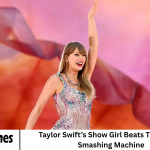In an era where technology dominates nearly every aspect of modern life, the collision between creativity and corporate power has become inevitable. This is the story of a crime novelist — celebrated for her gripping psychological thrillers.
Who found herself pitted against one of Silicon Valley’s most formidable tech giants. What began as a routine dispute over intellectual property evolved into a global conversation about privacy.
Artificial intelligence (AI), and the ownership of creative work in the digital age. This isn’t just a tale about one writer versus a multinational corporation — it’s a modern David-and-Goliath story that questions who truly owns creativity in the 21st century.
More Read: Iran Dismisses Cooperation with IAEA as Meaningless Following Return of Sanctions
The Rise of a Storyteller
Before her clash with the tech behemoth, Clara Dennison (a fictionalized composite character for this story) was a household name among readers of crime fiction. Her novels — The Shadow’s Confession, The Widow’s Code, and A Quiet Betrayal — topped bestseller lists around the world.
Known for her sharp psychological insight and vivid prose, Dennison built a loyal fan base who admired not only her storytelling but also her advocacy for writer’s rights.
Her books often explored the dangers of surveillance, manipulation, and the blurred boundaries between morality and technology. Ironically, these same themes would soon transcend the pages of her fiction and consume her real life.
The Algorithmic Intrusion
In 2023, Dennison began noticing peculiar coincidences. A new AI-driven writing platform called StoryFlow, owned by a major Silicon Valley company — let’s call it TechCore — had released an AI “story generator” that seemed eerily familiar.
Users reported that the AI could produce intricate crime plots, complete with realistic dialogue and emotional depth — strikingly similar to Dennison’s signature writing style.
After some investigation, Dennison discovered that TechCore’s AI had been trained on millions of copyrighted books, including her own. Without permission, the company’s machine-learning models had ingested her creative output, “learning” to replicate her voice, tone, and character archetypes.
“I felt like I was reading an AI-generated version of my soul,” Dennison told The Literary Review. “It wasn’t just about copying words. It was about stealing the creative DNA that took me decades to develop.”
The Legal Storm
Refusing to remain silent, Dennison assembled a team of lawyers and filed a landmark lawsuit against TechCore, alleging copyright infringement and unethical data practices.
The lawsuit quickly became headline news. Legal analysts noted that Dennison’s case could set a precedent for how intellectual property laws apply in the age of generative AI. If successful, it might redefine the boundaries between creativity, technology, and data ownership.
TechCore, for its part, denied any wrongdoing. The company maintained that the data used to train its AI models fell under the doctrine of “fair use,” a legal principle allowing limited use of copyrighted material for purposes like education or research.
But Dennison’s lawyers argued that commercial AI systems generating content for profit did not qualify as fair use. They contended that the AI’s output was derivative, effectively competing with human authors in the marketplace.
The legal question — can machines ethically or legally imitate human art? — sparked a firestorm across the creative world.
The Public Divide
The reaction was polarizing. Many writers, artists, and musicians rallied behind Dennison, seeing her as a champion of creative integrity. The Writers’ Guild of America, which had recently negotiated its own AI-related protections, voiced strong support.
A global campaign called #AuthorsNotAlgorithms began trending on social media, demanding stricter regulations for AI training data. On the other hand, tech advocates argued that innovation requires openness and that restricting data access could stifle progress.
They compared AI’s learning process to how human writers draw inspiration from reading other works. “Every artist learns by imitation,” one AI researcher tweeted. “We stand on the shoulders of giants. So do machines.”
But Dennison’s supporters countered that there’s a difference between inspiration and exploitation — between reading a book and absorbing it into a billion-dollar algorithm.
The Emotional Toll
As the case dragged on, Dennison found herself under immense pressure. TechCore’s legal team, known for its aggressive tactics, filed counterclaims accusing her of defamation and interference with business operations.
Meanwhile, online harassment intensified. Bot accounts — many suspected of being generated by AI tools — flooded her social media with vitriol. “It felt like fighting an army of ghosts,” Dennison later wrote in her memoir Words Against the Machine.
Friends described her as “haunted but resolute.” She stopped attending book festivals, fearing public confrontations. Yet she continued to write, channeling her turmoil into her next novel, The Silicon Veil, a chilling story about a writer who battles an omnipotent tech conglomerate.
The Courtroom Showdown
The trial, held in a San Francisco federal court, drew global attention. Lawyers, journalists, and tech ethicists packed the courtroom to witness what many dubbed “the copyright case of the century.”
Dennison’s legal team presented evidence showing that TechCore’s AI had reproduced distinctive narrative patterns, character structures, and even specific metaphors from her novels. Expert witnesses testified that the AI’s writing was not coincidental — it bore the unmistakable fingerprint of Dennison’s linguistic style.
TechCore’s defense hinged on the argument that the AI’s output was transformative, not derivative — that it created new works based on learned data rather than copying existing texts. The company’s chief AI scientist claimed the model had no awareness or intent and that its “learning” was statistical, not creative.
The trial illuminated the profound legal gray zone of the digital age: can machines “steal” creativity when they lack human consciousness? Or is the true theft committed by the corporations that deploy them for profit?
The Verdict
After months of deliberation, the court delivered a mixed but historic ruling. The judge acknowledged that AI models trained on copyrighted works without consent did infringe upon intellectual property, particularly when used for commercial gain.
However, the court stopped short of imposing a full ban on such practices, instead ordering TechCore to compensate Dennison and other affected authors through a newly established licensing fund.
Dennison’s victory was symbolic rather than total — but it sent shockwaves across the tech world. For the first time, a major legal body recognized that creative content used in AI training had economic and moral value.
Within weeks, other authors, screenwriters, and journalists filed similar suits. Major AI companies began negotiating new frameworks for data licensing, pledging greater transparency in how their systems learn.
The Cultural Fallout
Beyond the courtroom, Dennison’s stand ignited a broader cultural reckoning. Universities hosted symposiums on “Ethics in Artificial Creativity.” Lawmakers in the U.S. and Europe introduced bills to regulate AI data sourcing.
Meanwhile, Dennison’s story inspired filmmakers, musicians, and digital artists to question their own relationship with technology. A biopic adaptation, The Writer vs. The Machine, entered development soon after, with critical acclaim predicted even before filming began.
For Dennison, the case became a personal turning point. “I didn’t fight to destroy technology,” she told The Guardian. “I fought to remind the world that creativity isn’t code. It’s human experience distilled into language, art, and emotion. That can’t be replicated — only imitated.”
Lessons for the Future
The implications of Dennison’s battle continue to shape debates about AI ethics, digital rights, and artistic ownership. The case underscores a profound tension in modern society: how do we protect human creativity while still encouraging technological innovation?
Experts propose several solutions:
- Transparent AI training datasets that disclose exactly what material is used.
- Compensation systems where artists can license their work for AI learning.
- Ethical design standards ensuring AI tools respect creative boundaries.
Dennison’s case has become a blueprint for navigating these challenges — a reminder that even in the age of automation, human creativity remains irreplaceable.
Frequently Asked Question
Who is the crime novelist who challenged a Silicon Valley giant?
The story centers on Clara Dennison, a bestselling crime novelist who sued a major tech company, TechCore, over unauthorized use of her copyrighted works to train an AI language model.
What was the main issue in the lawsuit?
Dennison alleged that TechCore’s AI used her novels without permission, effectively copying her writing style and content to generate similar stories, violating copyright laws.
How did the tech company defend its actions?
TechCore argued that its use of copyrighted material fell under “fair use” for the purpose of developing AI and that the AI’s output was transformative rather than derivative.
What was the court’s final decision?
The court ruled partially in Dennison’s favor, recognizing that AI systems trained on copyrighted works for profit could constitute infringement. It ordered TechCore to compensate affected authors through a licensing fund.
Why is this case significant?
This case marked the first major legal recognition of authors’ rights in the context of AI training data, setting a precedent for how creative works are protected in the age of artificial intelligence.
How did the public respond to the case?
The public response was divided. Many artists and writers supported Dennison’s fight for creative rights, while some technologists argued that restricting data access could hinder AI innovation.
What impact has the case had on the future of AI and creativity?
The ruling prompted tech companies to adopt more transparent data policies, encouraged new licensing frameworks for creative works, and ignited global debate about the ethical use of AI in creative industries.
Conclusion
“The Crime Novelist Who Challenged a Silicon Valley Giant” is more than just a story about one writer’s legal battle. It’s a reflection of our era’s defining struggle — between creation and consumption, between human imagination and machine efficiency.
In confronting TechCore, Clara Dennison became a symbol for millions of artists who refuse to let algorithms define the limits of art. Her courage sparked a movement that may one day ensure that creativity, in all its fragile brilliance, continues to belong to the humans who dare to dream it.








